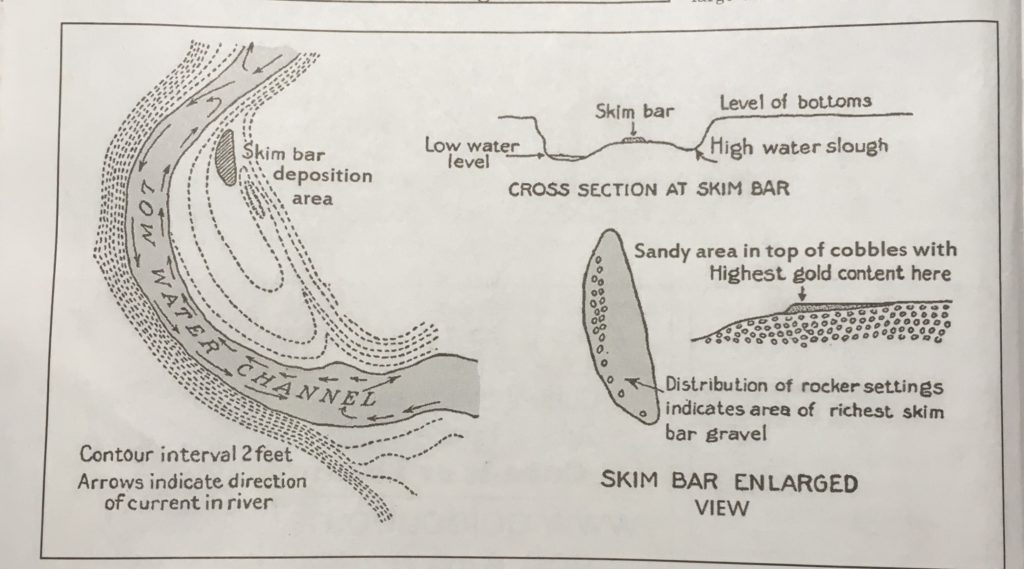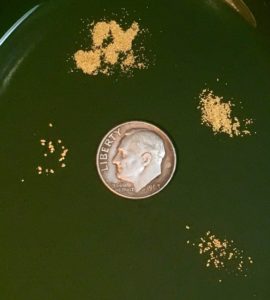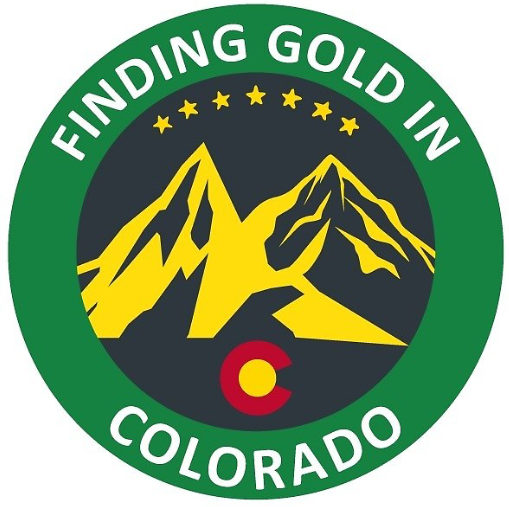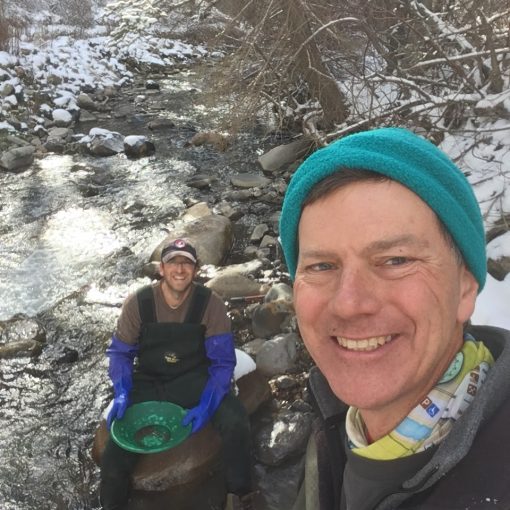Many of the waterways of Colorado are gold bearing and carry flood gold downstream during high water seasons. As many placer gold prospectors quickly learn, flood gold accumulates in cobble bars. Studying the details of how gold accumulates in a cobble bar will dramatically increase gold production for casual prospectors.
Prospectors usually know to dig on the upper end of a cobble bar or at its widest point to find good gold. Many will hit the spots with collections of larger rocks. All good strategies.
An additional key piece of knowledge for prospectors to understand is the “skim bar”. This is a formation that develops on top of a cobble bar where gold concentrates even more than elsewhere on the bar. Here’s an old diagram of how to identify a skim bar:

To find a skim bar, first stand back and examine the cobble bar to identify the high points. If the river is running low, can you see the high water slough as a sort of low creek running between the higher bank and the rest of the cobble bar? This creek may be wet or dry depending on current water levels but is always more shallow than the gut of the river which runs on the other side of the cobble bar. If you can see a high water slough, next examine the rest of the bar to identify high points. The high point may occur toward the upper end of the bar as illustrated above or it may be further downstream. Often these highpoints will have grass growing on them, especially late in the summer season. A large, long cobble bar may even have multiple skim bars. This seems especially true of large cobble bars on long gentle bends rather than hard bends.
As shown above, skim bars are often very sandy rather than covered in large cobble, don’t be discouraged, sample that sandy material. Sometimes you can see that the sand is darker but even when that’s not obvious, large amounts of black sand are common in Colorado skim bars. This means you’ll need serious skills to effectively process your concentrates. Read how to do that here. Additionally, skim bars will often be shallow, as in 4-8 inches deep. However, cobble bars are often multi-layered so deeper sampling may be wise too. Just be sure to sample pan as you go if you are running a sluice, high banker or dredge. Both good and bad results are possible.
Sampling the cobble bar carefully will often show the skim bar area has several times as much color as the rest of the bar does! I was working a large cobble bar recently (10/2018) and found the main bar had 20-30 fine colors per classified pan while the skim bar has 60-80!
If you find a skim bar, dig it …but then come back after another high-water year. You are likely to find the skim bar has been rebuilt and the good gold has refreshed. Cool stuff, eh?
A caution for those using sluices and powered equipment – skim Placer gold is very pure but also very small. This can mean your equipment setup has to be exactly right to catch the fine gold. I’ve certainly had the experience of setting up my gear slightly incorrectly and realizing some of the -100 mesh gold was escaping – on a skim bar this is disastrous since almost ALL the gold is -100 mesh. For me this means I prefer to set up my Gold Cube (read Gold Cube hints here) since I trust it to catch the ultra-fine gold. Sample pan your tailings as you go to monitor for losses.
Here’s a sample of my gold from a skim bar. The large pile at the top of the picture is all -125 mesh gold (60 micron and smaller) while the largest, on the left is +50 mesh. By weight most of the gold in this sample was well below 50 mesh, as is typical for a skim bar.


Here in Colorado, skim bars can be found on many of the major rivers. Some examples where you can dig for gold are described elsewhere on this website. They include Big Bend on the South Platte River (here) and the downstream part of Arapahoe Bar on Clear Creek (here). Many others can be identified if you go looking for them. These sites are mentioned in my book from the very first chapter in metro Denver including site A-07, to multiple spots on the Arkansas River, to the very last chapter including site R-06 out west on the Yampa River. Learn more about the prospecting guidebook here.
Go find a Colorado skim bar and you’ll most likely find YOUR gold!
******
This site costs money to keep up. The only way it makes money is shopping referrals. If you appreciate the info I’m sharing, please click thru one of my Amazon or Gold Cube ads the next time you want to shop online. It won’t cost you anything extra and it keeps the site going: Shop Amazon
or for more options like the shopping the Gold Cube website head to www.findinggoldincolorado.com/shop-here/




5 thoughts on “Prospecting Colorado Skim Bars”
Hi I am going to be traveling out to Colorado in the first week of Oct., and will be staying at the Cotopaxi KOA camp ground. I was wondering if you would have any good recommendations for any real good places around there to go prospecting?
Hi Joe! In my book I document all the legal spots along the Arkansas River, through the area where you’ll be, that are legal to pan. There are quite a few! I’d suggest you grab a copy of the book and start making plans. Water levels should be low so river access will be great! You can get the direct amazon link here: http://www.findinggoldincolorado.com/buy-the-book/
Thank You, I have the book and have read through it. I thought there might have been one place better than another. Also in your writing I noticed that you mention a prospectors edition is there a difference the book?
The Prospector’s Edition is the only published version of the book. I named it that way to make it obvious this is THE book for gold prospectors in Colorado.